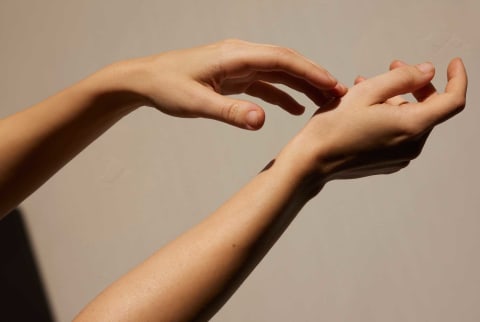A Derm & Skin Cancer Survivor Shares 3 Must-Have Sun Care Tips

Image by Guille Faingold / Stocksy
May 11, 2023
Our editors have independently chosen the products listed on this page. If you purchase something mentioned in this article, we may
Every beauty professional has their nonnegotiable steps. In our series Like a Pro, we tap experts for the top three techniques they absolutely swear by. Here, you’ll hear from a variety of industry insiders on the fail-safe tricks they always keep in their back pockets. We’re all about simplifying your beauty regimen wherever you can, and sometimes the best routines are as easy as 1, 2, 3.
Advertisement
This ad is displayed using third party content and we do not control its accessibility features.
Skin cancer is America’s most common cancer, but it’s also one of the most preventable. You can protect your skin with sunscreen and practice safe sun habits. You can get regular skin checks to detect any warning signs. And you can spread the word about the dangers of unprotected sun exposure, motivating others to preserve their own skin.
To help with the latter, we have board-certified dermatologist and skin cancer survivor, Ellen Marmur, M.D. “I made every terrible sun care mistake until I was 25 years old. I hit the tanning salons before prom, I competed with my friends to see who could get the most tan, I barely used sunscreen and never reapplied, and I never went for a skin check,” the founder of MM Skincare tells mbg. (This was back in the 90s when tanning, despite the dangers, was very much en vogue.)
Today, Marmur is a champion for skin cancer prevention, becoming a renowned expert in skin cancer diagnosis and surgery and the founder of her own philanthropy, Skin Cancer, Take a Hike! “Having three skin cancers was definitely a big shock and wake-up call,” she adds. “That was the 90s; this is now!”
Below, Marmur reveals what she wished she knew then—and the advice she shares with all of her patients now.
1.
Sun damage goes beyond burns
Sunburns may look different across skin tones: Some can be barely-there-pink to red and tender to the touch, while others may simply feel hot, overly sensitive, and itchy. No matter how you burn, you should know there are other markers of photodamage to keep in mind.
Freckles and dark spots—also called sunspots or age spots—are also signs of sun damage, as are wrinkles and crepey, fragile skin. And, sorry to say, sun damage can even look like a bronzed vacation glow: “Even if you do not burn, but still have tanned skin from the sun, you are exposing your skin to too much sun and not applying enough sunscreen,” says Marmur. “Tanning might feel great, but it is a sign of injury on a DNA level where mutations can occur. Tanning dissolves your collagen, leading to pebbled skin texture and mottled complexion.”
Advertisement
This ad is displayed using third party content and we do not control its accessibility features.
2.
Regular skin checks are key
Marmur encourages annual skin checks at the derm, but don’t forget to perform regular self-exams in between. “You should check your skin about once every month after the shower,” she explains. “Stand in front of the mirror and make sure to check everywhere—even behind your ears!” (On that note: Make sure to apply sunscreen to your ears; it’s an oft-forgotten spot!)
When performing a self-check, she recommends using the ABCDE’s of melanoma. We break down the technique in our complete mole versus freckle guide, but here’s a quick summary of what to look for:
- Asymmetrical: Is the spot even all the way around?
- Border: Irregular, scalloped, poorly defined, etc.
- Color: Red, blue, white, several shades of brown, etc.
- Diameter: Typically 6 mm is a warning sign
- Evolving: Changing in size, color, or shape in three months
Advertisement
This ad is displayed using third party content and we do not control its accessibility features.
Finally, don’t skimp on those annual checks: “Many people believe that skin cancer is something that only affects older people,” says Marmur, but we’re seeing increased incidences across a variety of populations. Be proactive by keeping tabs on your own spots and making sure to contact an expert if you notice any changes or peculiar features.
And while prevention is crucial, that doesn’t mean you can’t address any existing dark spots. “Helping to reduce the sun damage from chronic tans and sunburns can be achieved with green LED light, red LED light, fractional lasers like Fraxel [or] Clear + Brilliant, or microneedling with chemical peels to restore newer collagen,” notes Marmur.
Red light therapy, in particular, has been shown to reduce inflammation in the body1; while red, blue, and green light have all been shown to improve wounds in research2. “Additionally, red LED therapy can help reduce the appearance of fine lines and wrinkles,” she notes. Marmur’s MMSkincare MMSphere is a stellar at-home option, as it uses FDA-approved LED light technology and the same clinically-proven wavelengths as professional-grade in-office devices. Or you can feel free to browse even more LED devices here.
The takeaway
The sun is vital for skin health and well-being in general (absorb that vitamin D!), but you don’t want to overdo it. Make sure to protect your skin from sun damage by wearing sunscreen (our favorites, here), avoiding sunbathing for sport (you can achieve a faux glow with self-tanner), and regularly monitoring your skin for any notable changes—this Skin Cancer Awareness Month and beyond.
Advertisement
This ad is displayed using third party content and we do not control its accessibility features.









